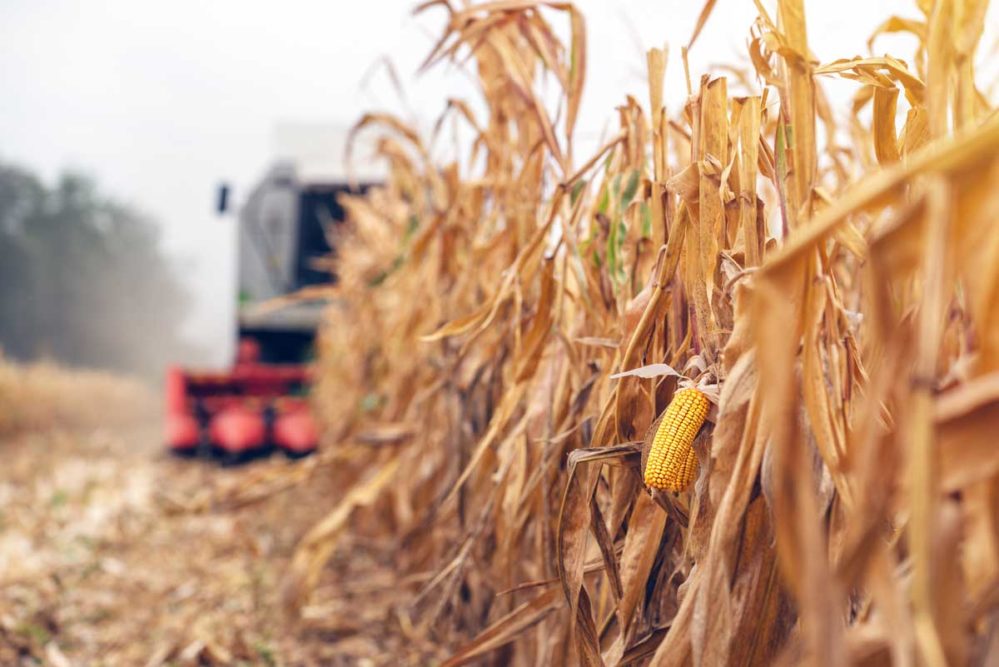KANSAS CITY, MISSOURI, US — Harvest of the US corn and soybean crops were ahead of their five-year averages as of Oct. 16, with this week’s frigid weather across key growing areas likely having minimal impact due to the advanced maturity of both crops, although individual late-planted fields, mainly of soybeans, likely were damaged.
The US Department of Agriculture (USDA) in its weekly Crop Progress report said 45% of the corn crop in the 18 major growing states was harvested as of Oct. 16, up from 31% a week earlier, behind 50% a year ago and ahead of 40% as the 2017-21 average for the date. The soybean crop in the 18 largest-producing states was 63% harvested, up from 44% a week earlier, ahead of 58% at the same time last year and well ahead of 52% as the prior five-year average for the date.
Of greater concern to the corn and soybean markets (and wheat) is export potential with most signals negative, including the strong value of the US dollar, which makes US exports more expensive, and an expected record-large soybean crop in Brazil that is still a few months from harvest.
Perhaps more importantly, the corn crop was 94% mature (97% last year, 92% as the average), and 96% of the soybean crop was dropping leaves (94% both last year and as the average), meaning hard freezes across most of the central and western Corn Belt, as far south as northeast Oklahoma and northern Arkansas, likely will have minimal impact. There certainly still were some fields of green soybeans in southern areas that were hit with temperatures in the mid-20s early this week that will not reach maturity, but the impact should be minimal on the overall crop. Rainfall that accompanied the weather system was much welcomed, especially across the dry Southern Plains where winter wheat was planted mostly in drought conditions.
Corn and soybean futures traded lower on Oct. 18 mainly on harvest pressure with no support from near record lows in some areas early that morning.
Of greater concern to the corn and soybean markets (and wheat) is export potential with most signals negative, including the strong value of the US dollar, which makes US exports more expensive, and an expected record-large soybean crop in Brazil that is still a few months from harvest. Threats from Russia to pull out of the agreement allowing grain exports to pass from Ukrainian ports through a Black Sea humanitarian corridor provided mixed signals depending on the rhetoric of the day.
The USDA in its Oct. 12 World Agricultural Supply and Demand Estimates report lowered from September its 2022-23 export forecasts for corn, soybeans and wheat. Corn exports were forecast at 2.15 billion bushels, down 25 million bushels from September “reflecting smaller supplies and slow early-season demand,” the USDA said. Soybean exports were projected at 2.045 billion bushels, down 40 million bushels “with increased competition from South America” the primary reason given by the USDA. And wheat exports were forecast at 775 million bushels, down 50 million bushels “on reduced supplies, slow pace of export sales and continued uncompetitive US export prices.”
Exports of all three commodities were forecast down from 2021-22 with wheat exports the lowest since 1971-72, which was just before the famous “Great Soviet Grain Robbery” of 1972 when Russia bought more than $1 billion worth of subsidized US grains and soybeans, including about 25% of the US wheat crop, that sent grain prices soaring.
Russia has since become the world’s largest wheat exporter and has wreaked havoc on the world grain market since its invasion of Ukraine on Feb. 24 that scuttled grain exports by sea from Ukraine. Russia’s threats to withdraw from the July agreement that allowed Ukraine’s exports to resume (after recent military victories by Ukraine against Russia) roiled markets in October.
The USDA raised from September its price forecasts for all wheat and corn but lowered its soybean price forecast. The average price of wheat paid to farmers in 2022-23 was forecast at $9.20 a bushel, up 20¢ from the September forecast, up 21% from 2021-22 and up 82% from 2020-21. The average corn price was forecast at $6.80 a bushel, up 5¢ from September, up 13% from 2021-22 and up 50% from 2020-21. The average soybean price paid to farmers was forecast at $14 per bushel, down 35¢ from September but up 5% from 2021-22 and up 30% from 2020-21.
The USDA in its Oct. 12 Crop Production report forecast the 2022 US corn crop at 13.895 billion bushels, down 0.4% from September and down 8% from 2021. The soybean crop was forecast at 4.313 billion bushels, down 1.5% from September and down 3.4% from 2021. The USDA on Sept. 30 estimated the US wheat crop at 1.650 billion bushels, down 7% from the prior forecast but up 4 million bushels from 2021.
Corn and soybean crops struggled with drought in the western Corn Belt most of the season, which contributed to lower estimates from the USDA.






